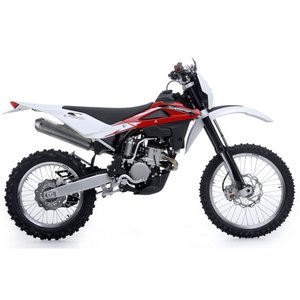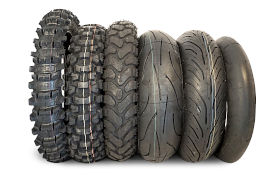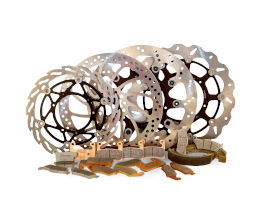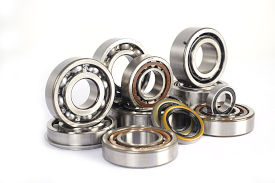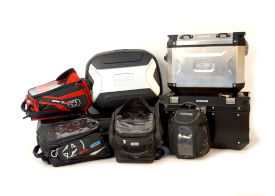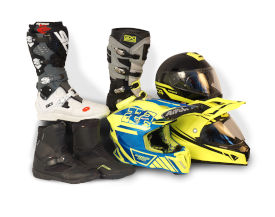Husqvarna TE 250 (2005–2010): A Legacy of Enduro Refinement Tested in the Modern Era
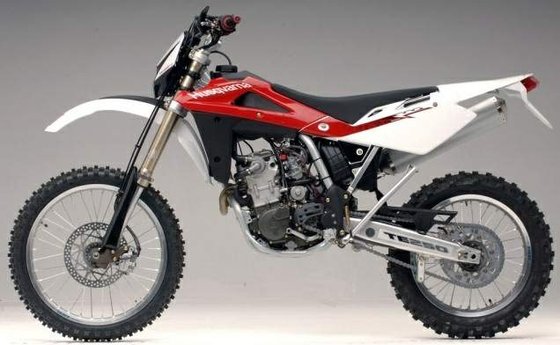
Introduction
The Husqvarna TE 250 isn’t just a motorcycle—it’s a statement. Born from a brand steeped in off-road racing heritage, this 250cc enduro machine carved its niche between 2005 and 2010 as a lightweight, agile, and technologically advanced option for riders who demanded precision on unforgiving terrain. Having recently thrown a leg over a well-preserved 2008 TE 250, I can confirm that this bike’s reputation isn’t just nostalgia. It’s a time capsule of engineering that still holds its own against modern competitors, thanks to its relentless focus on adaptability, power delivery, and rider-centric design. Let’s dive into what makes this generation of the TE 250 a standout, even by today’s standards.
Design and Build: Swedish Roots, Italian Flair
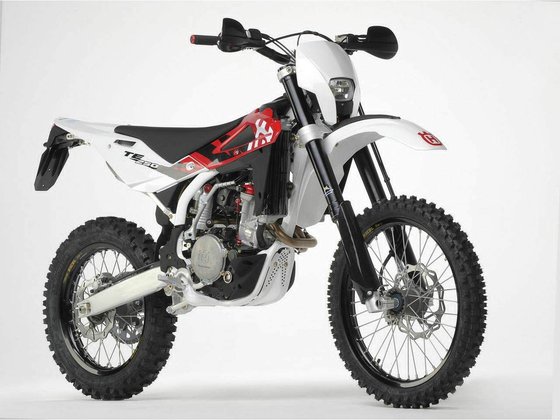
The TE 250’s design ethos blends Scandinavian minimalism with Italian racing flair. From 2005 to 2010, the bike underwent subtle visual evolutions, transitioning from bold blue/yellow livery to the iconic red/white scheme post-2007—a nod to Husqvarna’s revitalization under BMW ownership. But aesthetics are just the surface. The chassis tells the real story: a steel single-tube cradle frame paired with a lightweight aluminum rear subframe. This combo strikes a balance between rigidity and flex, critical for absorbing impacts while maintaining control at speed.
Key upgrades during this generation include:
- 2008 Fuel Injection: Replacing the Keihin carburetor with EFI transformed throttle response.
- Brembo Brakes (2007+): Enhanced stopping power with 260mm front/220mm rear discs.
- Redesigned Ergonomics: A narrower seat (lowered by 10mm in 2008) improved rider mobility.
Weighing just 108 kg (238 lbs) dry, the TE 250 feels shockingly nimble—like a mountain bike with a heart of fury. The components scream quality: Marzocchi 50mm USD forks (300mm travel) up front and a Sachs shock (290mm travel) at the rear, both fully adjustable. Even the footpegs are oversize, offering a stable platform for aggressive riding.
Engine Performance: Carb to EFI Evolution
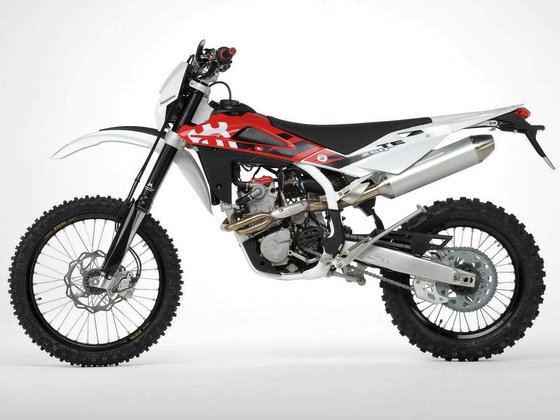
At the heart of the TE 250 lies a 249cc liquid-cooled DOHC four-stroke, a powerhouse that evolved significantly during this era. Early models (2005–2007) used a 38mm Keihin carburetor, delivering crisp throttle response and a linear powerband. But the 2008 overhaul introduced Mikuni fuel injection, a game-changer that eliminated bogging and provided instant torque in technical sections.
Riding the 2008 model, the difference is palpable. Crack the throttle, and the front wheel lifts effortlessly—no clutch fanning required. The engine pulls cleanly from 2,500 RPM, with a meaty midrange that’s perfect for lofting over logs or accelerating out of berms. The six-speed transmission (a 2006 upgrade from five speeds) ensures versatility, whether crawling in first gear or hitting 110 km/h (68 mph) on fire roads.
By 2010, Husqvarna added a dual-map CDI, letting riders toggle between “soft” (for slippery conditions) and “hard” (full aggression) modes—a feature that still feels cutting-edge. Maintenance? The engine’s dry-sump design simplifies oil changes, and the stainless steel valves are notoriously durable.
Handling and Suspension: Master of the Mixed Bag
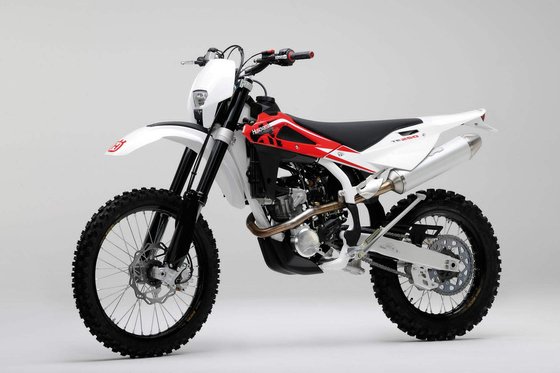
The TE 250’s handling is where it truly shines. On tight singletrack, the bike flicks between trees with the urgency of a trials machine. Yet, it remains stable at speed, thanks to a 58.5-inch (1,485mm) wheelbase and near-perfect weight distribution. The 21-inch front/18-inch rear spoked wheels (with Michelin Enduro tires on our test bike) bite into loose soil and rock gardens with tenacity.
The suspension setup deserves praise. The Marzocchi forks are plush on small bumps yet resist bottoming on big hits—once dialed in via compression/rebound adjustments. Out back, the Sachs shock pairs with a “Soft Damp” linkage to balance comfort and progression. During our test, the bike handled motocross jumps, river crossings, and rocky ascents without breaking a sweat.
A 2010 chassis revision improved durability, with reinforced footpeg mounts and a redesigned skid plate. Translation: this bike can take a beating.
Braking System: Confidence in the Chaos
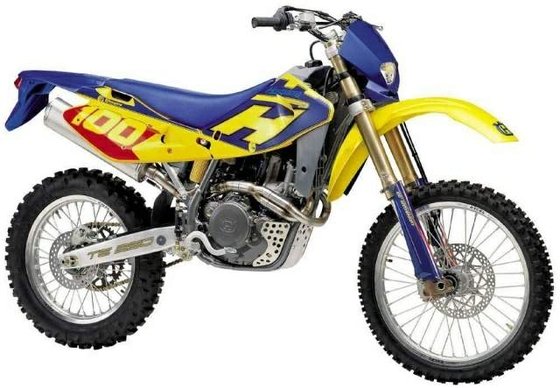
Post-2007 models equipped with Brembo calipers offer sublime braking. The 260mm front disc delivers a progressive bite, avoiding the “on/off” feel of some competitors. On steep descents, the rear 220mm disc provides ample control without locking up easily. Combined with the bike’s light weight, stopping distances are impressively short—critical when navigating surprise obstacles.
Ergonomics and Comfort: Built for Battle
Standing at 963mm (38 inches), the seat height is manageable for average riders, and the narrow profile lets you grip the tank effortlessly. The handlebar position is neutral, reducing arm pump during long rides. That said, the seat foam is firm—a common gripe in early models. Thankfully, aftermarket options (like MOTOPARTS.store’s gel seat) solve this.
The 7.2-liter (1.9-gallon) fuel tank limits range to ~100 km (62 miles) under hard riding, but a 2010 upgrade to 8.5 liters (2.2 gallons) helped. Still, serious enduro riders might opt for a larger aftermarket tank.
Competition: How the TE 250 Stacks Up
The TE 250’s rivals during its era included the Yamaha WR250F and KTM 250 EXC. Here’s how they compare:
| Aspect | Husqvarna TE 250 | Yamaha WR250F | KTM 250 EXC |
|----------------------|------------------------------------------|----------------------------------|----------------------------------|
| Engine | EFI (2008+), broad torque | Carbureted, peakier power | Carbureted, aggressive delivery |
| Transmission | 6-speed | 5-speed | 6-speed |
| Weight | 108 kg (238 lbs) | 112 kg (247 lbs) | 110 kg (243 lbs) |
| Suspension | Marzocchi/Sachs, fully adjustable | KYB, less tunable | WP Suspension, race-ready |
| Price (New) | N/A | N/A | N/A |
Advantages of the TE 250:
- EFI Superiority: Post-2008 models outpace carbureted rivals in throttle response.
- Six-Speed Gearbox: More versatile than Yamaha’s five-speed.
- Component Quality: Marzocchi/Brembo/Sachs vs. Yamaha’s budget-oriented parts.
Where It Lags:
- Aftermarket Support: Yamaha and KTM have broader accessory ecosystems.
- Seat Comfort: Stock seats are notoriously firm.
Maintenance: Keeping the Legend Alive
The TE 250 is refreshingly low-maintenance for a high-strung enduro bike. Key tips:
1. Oil Changes: Every 15–20 hours using 10W-50 synthetic. The magnetic drain plug catches metal shavings—check it regularly.
2. Air Filter: Clean every 2–3 rides. The 2010 redesign improved water resistance, but a pre-oiled filter (available at MOTOPARTS.store) adds insurance.
3. Valve Adjustments: Check every 40–50 hours. Shim-under-bucket design requires patience but isn’t prone to sudden failures.
4. Suspension Servicing: Rebuild forks/shock every 100 hours. Upgrade to SKF seals for durability.
5. Chain/Spockets: Replace with DID X-Ring chains and steel sprockets for longevity.
Common Upgrades:
- Exhaust: A slip-on like the FMF Q4 reduces weight and boosts midrange.
- Handguards: Barkbusters protect levers in crashes.
- Skid Plate: Aluminum models shield the engine from rock strikes.
Conclusion: The Timeless Enduro Warrior
The Husqvarna TE 250 (2005–2010) is a masterclass in balancing aggression and control. Its evolution from carbureted underdog to EFI-equipped champion mirrors the golden age of enduro innovation. While modern bikes boast traction control and ride modes, the TE 250 reminds us that raw mechanical synergy—lightweight chassis, torquey engine, and premium suspension—can still dominate trails. Whether you’re resurrecting a barn find or upgrading a well-loved example, MOTOPARTS.store has the gear to keep this legend shredding for another decade.
Ride hard, ride smart, and let the Husky’s howl echo through the woods.
Specifications sheet
| Engine | |
|---|---|
| Stroke: | Four-stroke |
| Starter: | Electric & kick |
| Ignition: | Electronic |
| Fuel system: | Electronic Fuel Injection (2008-2010); 38mm Keihin MX carburetor (2005-2007) |
| Displacement: | 249 ccm |
| Configuration: | Single |
| Cooling system: | Liquid cooled |
| Compression ratio: | 12.9:1 (2008-2010); 12.0:1 (2005-2007) |
| Number of cylinders: | 1 |
| Dimensions | |
|---|---|
| Width: | 820 mm (32.2 in) |
| Length: | 2267 mm (89.2 in) |
| Wheelbase: | 1485 mm (58.5 in) |
| Dry weight: | 108 |
| Seat height: | 963 mm (38.0 in) (2008-2010); 890 mm (35.0 in) (2005-2007) |
| Ground clearance: | 300 mm (11.8 in) |
| Fuel tank capacity: | 8.5 L (2.2 US gal) (2010); 7.2 L (1.9 US gal) (2008-2009); 8.0 L (2.1 US gal) (2005-2007) |
| Drivetrain | |
|---|---|
| Clutch: | Wet multiplate hydraulic |
| Final drive: | chain |
| Gear ratios: | 1st: 28.205, 2nd: 22.721, 3rd: 18.803, 4th: 15.329, 5th: 12.974, 6th: 11.491 |
| Chain length: | 118 |
| Transmission: | 6-speed |
| Rear sprocket: | 47 |
| Front sprocket: | 15 |
| Maintenance | |
|---|---|
| Rear tire: | 120/80-18 |
| Engine oil: | 10W40 |
| Front tire: | 90/90-21 |
| Brake fluid: | DOT 4 |
| Spark plugs: | NGK CR8E |
| Coolant capacity: | 1.2 |
| Forks oil capacity: | 1.2 |
| Engine oil capacity: | 1.2 |
| Engine oil change interval: | Every 15 hours off-road use |
| Valve clearance (intake, cold): | 0.10–0.15 mm |
| Valve clearance check interval: | Every 50 hours |
| Valve clearance (exhaust, cold): | 0.20–0.25 mm |
| Additional Features | |
|---|---|
| ABS: | Not equipped |
| Wheels: | Aluminum rims with CNC-machined hubs |
| Exhaust: | Titanium header with aluminum silencer |
| Instrumentation: | Minimalist off-road dashboard |
| Frame protection: | Reinforced engine guards (2010) |
| Chassis and Suspension | |
|---|---|
| Frame: | Steel single tube cradle with aluminum rear subframe |
| Rear brakes: | 220mm disc with 1-piston Brembo caliper |
| Front brakes: | 260mm disc with 2-piston Brembo caliper |
| Rear suspension: | Sachs Progressive Soft Damp monoshock, preload/compression/rebound adjustable (290mm travel) |
| Front suspension: | Marzocchi USD 50mm telescopic fork, compression/rebound adjustable (300mm travel) |
| Rear wheel travel: | 290 mm (11.4 in) |
| Front wheel travel: | 300 mm (11.8 in) |



